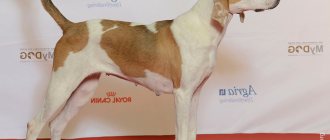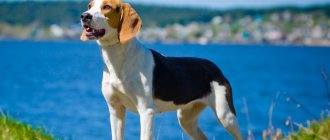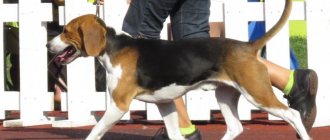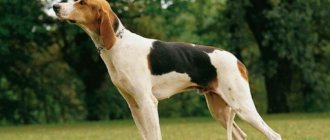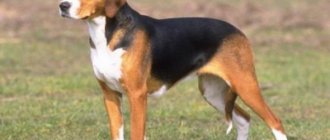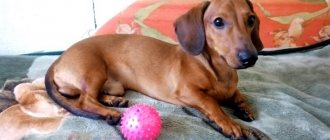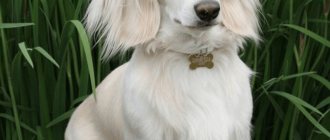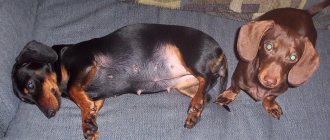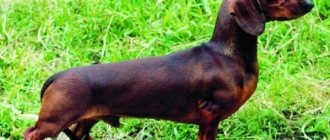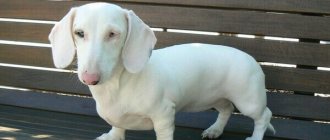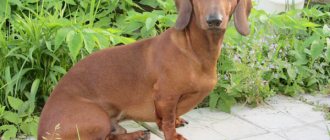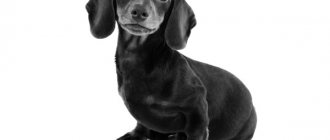The Dachshund is one of the most famous and recognizable breeds in the world.
Its characteristic appearance - a strongly stretched body, short legs, long ears, noble contours of the muzzle and a not too thick tail allow one to unmistakably determine that this is a dachshund, and not some other dog.
But there are many other breeds in the world, the representatives of which are more or less similar to dachshunds.
Therefore, when you see a dog in front of you that looks like a dachshund, there is no need to rush to conclusions. Perhaps it is just another breed similar to it.
Varieties of dachshunds
There are three size varieties of dachshunds:
- standard _ Weight - about 9 kg, chest circumference - from 35 cm;
- dwarf _ Weight is from 4 to 5.5 kg, chest circumference is 30-35 cm;
- rabbit _ Average weight - 3.5-4 kg, chest circumference - up to 30 cm.
Based on their coat type, dachshunds are also divided into 3 varieties:
- smooth- haired The coat is very short, close to the body, but should not be rough;
- long- haired On the head and muzzle the hair is close-fitting and very short. On the ears, limbs and body the hair is much longer;
- - haired The fur feels like wire, not too long, thick and dense, forming a mustache, beard and eyebrows on the face.
Special characteristics of certain types of dachshunds
Dachshunds are bred in three types of different coats:
- Shorthaired dachshund.
- Long-haired dachshund.
- Wire-haired dachshund.
All three types must equally meet the above criteria. For each of these types the following provisions apply:
Short haired dachshund
Coat. The coat is short, thick, shiny, lying smoothly over the entire body, without bare spots. Special coat faults: too soft, fine coat, hairless ends of the ears, bare spots or too coarse, too long coat in general.
Tail. Dry, elegant, well coated but not excessively. Slightly elongated guard hairs on the underside of the tail are a sign of a strong predisposition to profuse hair, but are not considered a fault. A brush on the tail is a defect, just like the absence of hair partially or along the entire length of the tail.
Color of coat, nose and claws
- Single-colored dachshunds. The color is red, reddish-yellow, yellow all over the body or mixed with black hair. However, the pure color is preferred and the auburn color is considered more valuable than the reddish-yellow and yellow. Dachshunds with dark brindle colors belong to the same group. The nose and claws are black. Auburn color, although acceptable, is undesirable.
- Two-colored dachshunds. Lacquered black, brown, gray or white with rusty brown or yellow markings above the eyes, on the sides of the muzzle and lower lip, on the inside of the ears, on the front of the chest, on the inside and back of the legs, on the paws; around the anus and from there to about one-third or one-half of the underside of the tail. The nose and claws of black dogs are black, those of brown dogs are brown or black, and those of gray or white dogs are gray, however, sometimes they are flesh-colored, which is undesirable. White dogs have a preference for black markings. In other solid colors, with the exception of white dachshunds, white markings are undesirable, but if they are present in the form of separate small spots, they will not disqualify the dog.
- Spotted, brindle and striped dachshunds. The main coat color of the brindle dachshund is light, reddish, gray, up to white with dark irregularly shaped ragged spots (large spots are undesirable) of dark gray, brown, red or black. It is advisable that light or dark color does not predominate. The color of the striped dachshund is red or yellow with dark stripes. 3) The nose and claws are the same color as monochromatic dachshunds.
Longhaired dachshund
A distinctive feature in comparison with the short-haired dachshund is its long, thin, silky coat.
Coat. Soft, straight, shiny hair lengthens on the throat, along the entire underside of the body, especially on the ears and on the back of the legs, forming beautiful feathering on them. The fur reaches its greatest length on the lower part of the tail. The decorative hair on the ears should extend through their lower edge. Short hair at the ends of the ears, the so-called leathery ends of the ears, is undesirable. Too much hair on the paws (the so-called flippers) is unsightly and is unsuitable for working use of a dachshund.
Tail . The tail, being a smooth continuation of the line of the back, does not rise above its line and is covered with the longest hair, forming a beautiful dewlap on its lower part.
The fault is that the coat is excessively long throughout the body, too wavy or shaggy. Lack of tail feathers or excessively drooping ear hair. The hair that forms a parting along the ridge is too long between the toes.
Color of the nose and claws. Same as the short-haired dachshund.
Wirehaired dachshund
General form. Same as the shorthaired dachshund.
Coat. With the exception of the muzzle, eyebrows and ears, the dog's entire body is covered with uniform, close-fitting, thick, wiry hair with a dense undercoat. There is a beard and mustache on the face. Shaggy eyebrows. On the ears the hair is short, almost smooth, but consistent with the general type.
Color . All colors are acceptable. White markings on the chest, although acceptable, are not desirable. Otherwise, the same principles apply as for the short-haired dachshund.
Disadvantages are soft hair in general (short or long), or long hair on some parts of the body, trailing in all directions, curly or wavy hair and feathering on the tail. The tail is covered with coarse, but if possible, tight-fitting hair, shortening towards the end of the tail, without dewlap. The overall coat should give the impression that from a distance the wirehaired dachshund looks like a shorthaired one.
What breeds are similar to the dachshund?
There are many breeds in the world whose representatives may look similar to a dachshund.
First of all, these are hounds, such as the Austrian smooth-haired Brack, which looks like a large black and tan dachshund with fairly long legs.
Here are some other dog breeds that are most similar in build to dachshunds:
- Australian Terrier;
- Artesian-Norman Basset;
- basset hound;
- Pembroke Welsh Corgi;
- blue Gascony Basset;
- Dandie Dinmont Terrier;
- drever;
- Sealyham Terrier;
- Skye Terrier;
- Scotch Terrier.
All of them are distinguished by a highly stretched body structure.
There are also a number of breeds similar to dachshunds in head shape, but long-legged:
- Austrian hound;
- Austrian big-breasted brakk;
- Alpine dachshund hound;
- Bavarian mountain hound;
- Schiller hound;
- Polish hound;
- Polish ogar;
- Slovakian hound.
There are also breeds similar to dachshunds, but with larger ears. In addition to Basset Hounds, these include much taller Bloodhounds or Swiss Hounds.
IMPORTANT!
There are no long-legged dachshunds, since the breed standard states that the legs of these dogs should be shortened.
The long story of the long dog
The title is not without reason. The history of the Dachshund breed is truly one of the longest when it comes to hunting dogs specializing in burrowing.
The dachshund is the ultimate hunting dog, and its original shape is what makes these dogs excellent burrow hunters.
Of course, a dachshund won’t get into a mouse hole (but it will certainly dig it), but these dogs got into badger holes very easily, which is why hunters all over the world value this breed.
One version of the origin of the dachshund takes us to the ancient bank of the Nile River, in Egypt.
Images of people with animals with a characteristic body shape reminiscent of modern dachshunds have been found there more than once.
However, officially (that is, there is already documentary evidence) the history of this breed originates in Southern Germany in the 16th century.
The ancestors of short-legged hunters were German hound dogs, which passed on a number of hunting skills to dachshunds.
Photo 2. The Dachshund breed has a long history.
It was from them that the ability of dachshunds to pursue prey with a system of sound signals for hunters was inherited, as well as all the best hunting qualities, from intellectual abilities (dachshunds are very smart) to courage.
Dachshunds have a second name - Dachshund (German - badger dog).
This name was assigned to these dogs at a time when people realized their indispensability in catching badgers.
And even though the dachshund could not always pull the badger out, being underground, she pointed out exactly where to dig.
While the men shoveled, the dog held the badger in place. And it was not difficult to hear her even from under the ground cover - dachshunds have a very loud voice.
For reference: another breed of dog that specialized in “smoking” an animal out of its hole is the Jack Russell Terrier.
As a type of hound dog, dachshunds have not lost these instincts over the centuries.
Even though nature deprived them of long legs and fast running, they did an excellent job of finding wounded animals, and still do.
The selection work to develop this breed as we know it was aimed at obtaining a squat breed capable of “earth” work, with a good voice and a muscular body.
And the German specialists did it more than well.
Dachshunds retained their excellent toughness, which in many cases made them indispensable for catching foxes and badgers.
The toughness of a dog is its ability to restrain an animal by barking. A kind of “siege” that dachshunds can carry out for large periods of time.
Dachshunds began to gain their popularity in the 19th century, all in Germany. Breeders specializing in this breed appeared, and more and more people became interested in such unusual hunters.
The first breed standard was published and adopted in 1870, and the current international breed standard was adopted in 1979.
Basset Hound
Description
A good-natured and affectionate dog of low stature with a deep chest and a strongly elongated heavy body. The coat is short and thick.
A characteristic feature of Bassets is their very long, low-set, drooping ears, as well as a friendly look in their eyes, which gives these dogs a somewhat melancholy expression.
The most typical colors are tri-color and reddish-white, but any hound color is acceptable.
Basset Hounds measure from 28 to 38 cm and weigh 20-34 kg.
Character
Basset Hounds are affectionate, good-natured and non-aggressive dogs that, with proper socialization, get along well in the home with other animals. They are very good with children and love to play.
NOTE!
Basset hounds are sensitive and vigilant, and their voice, due to its special timbre, sounds quite menacing, making them good watchdogs.
Peculiarities
With proper training, Basset Hounds become obedient and well-mannered dogs.
However, the hunting instinct and independent, and sometimes stubborn disposition often lead to the fact that the basset, left to its own devices, goes to investigate some trail and can get lost because of this.
Other types
In the canine literature, types of dachshunds are distinguished depending on their size. In this case, the main parameters are taken into account:
During the selection process, 3 groups of animals emerged and were named:
Ordinary adult individuals are characterized by average sizes: height 0.2-0.27 m, body weight up to 9 kg, chest volume 35 cm. The dwarf type is somewhat smaller: height 0.14-0.21 m, weight 4-5.5 kg , chest girth 30-35 cm. Rabbit dachshunds belong to the category of mini pets. Their height at the withers does not exceed 0.15 m. Mature animals weigh approximately 3.5 kg. The chest reaches a volume of up to 30 cm.
Dogs of standard sizes have full hunting properties; small varieties were bred for decorative purposes. They do an excellent job as pets. Miniature dachshunds appeared on Russian territory at the end of the 20th century.
Artesian-Norman Basset
Description
These dogs, bred in the north of France, are distinguished by their relatively light build. Dimensions are 30-36 cm, and weight is 15-20 kg.
Artesian-Normandy Bassets have an elongated body and short legs. Their head is smaller in proportions than that of a basset hound; moreover, there are no wrinkles on the forehead and the expression in their eyes is not melancholic, but focused and interested. The ears are long and rather thin, forming soft folds. The coat is short and smooth, and the predominant colors are tri-color or red and white.
Character
Friendly and calm dogs.
They are not characterized by aggression towards people, however, due to their highly developed hunting instincts, they are less suitable than Basset Hounds for the role of pets.
Peculiarities
Dogs of this breed were bred specifically so that they would not run too far from a hunter on foot.
In addition, frightened game, seeing that the dog chasing it is not very playful, runs much slower, which allows the hunter to aim more accurately.
Boys and girls dachshunds. External differences
The external differences of dogs are standard. The sex of a puppy can be distinguished by its sexual characteristics. In a male dog, the organ is located at a certain distance from the anus and the testicles are visible, while in females the organ resembles a heart and is located close to the anus.
Females are slightly more modest in size, but girls are not much smaller than boys, and must fit into the standards for height and length. Thus, a dwarf female at the withers is only 14-19 cm. The weight is also much less than that of males, they are more refined, the head size is smaller, and the body is more collected and toned.
Spaniels
Description
A group of hunting dog breeds, descended from medieval Spanish dogs, whose purpose was to hunt game birds from dense thickets. Currently, spaniels are divided into those who hunt on land and the so-called “water ones”.
All spaniels share common characteristics of the breed - long ears and, as a rule, soft and silky, straight, wavy or even curly hair.
Most spaniels are short in stature. Only the Irish Water Spaniel, which measures 51-59 cm, can be considered a large breed.
Among modern spaniels there are also such exotic breeds as the Tibetan spaniel and Japanese chin. Despite their name, they are not related to real spaniels and are considered to be decorative dogs.
The colors of spaniels can be very diverse, both single-color and bicolor or tricolor.
Character
Spaniels are characterized by poise, affection, activity, friendliness, intelligence and intelligence. They make not only excellent hunting dogs, but also wonderful companions - favorites of the whole family.
Corgi is the perfect pet
Owners will be pleased to know that corgis are at the top of the rankings of the smartest dogs. Pembrokes are diligent students and quickly learn even complex commands, are devoid of aggression and are always happy to please their master. Dogs get along well with children and can run around with them all day long.
Like all herding breeds, corgis need close communication with the owner, and this is inherent almost at the genetic level, which is why they understand their adored owner even at a glance. The dogs are positive and cheerful, not touchy and affectionate. Almost any activity brings joy to them - playing, taking a bath, or even just relaxing. Pembrokes smile amazingly, charging everyone around them with positivity.
As for dachshunds, they are more ambiguous - they are touchy, do not like training too much, and are often cunning and stubborn. In general, all these qualities are inherent in many hunting breeds. In addition, if a Pembroke can be safely let off the leash and not be afraid that the pet will rush after a passing cat or mouse, then in dachshunds their unbridled hunting instinct often manifests itself.
Pembroke Welsh Corgi
Description
Welsh Corgi , despite its small height, not exceeding 30 cm, is a shepherd dog.
Bred in Wales in the early Middle Ages, these dogs were widespread throughout Britain as early as the 10th century AD. Their main purpose was to herd livestock.
According to one legend, Pembroke Welsh Corgis were given to people by fairies, who used them instead of draft animals.
Pembrokes have short straight legs, a highly elongated body, large erect ears and a fox-like muzzle. A characteristic feature of these dogs is the black edging of their lips, which gives the impression that the dog is smiling.
The coat is shiny and silky, reaching approximately the same length as a German Shepherd, the undercoat is short and water-resistant. The color can be red and white, tricolor or fawn, sometimes black. The tail is usually short by nature or docked.
Character
Pembrokes are friendly, active and affectionate dogs. They are good with other animals and children and love to play.
Peculiarities
Pembroke dogs are very smart dogs, occupying second place in the ranking of the smartest breeds in terms of intelligence.
Usually, they do not speak often, but when greeting the owner who has returned home, some Welsh Corgis perform a kind of “song”, which is a characteristic howl with modulations.
What do Pembrokes look like?
These are small dogs - their height is about 30 cm, and they weigh on average 10-12 kg. Their coat is hard, of medium length with a thick, dense undercoat. The Pembroke's tail is short; in the past it was always docked, making it as short as possible. The purebred representatives have a fox-like face with funny erect ears and penetrating, intelligent eyes.
Dachshunds, Corgis, Basset Hounds and other dogs with a similar body structure have one problem in common - a tendency to damage the spinal column. Their owners are advised to carefully monitor their pet's diet and avoid overeating, otherwise the short legs will not be able to support the weight of the overgrown animal.
It is necessary to exclude situations where the dog would have to jump high - from high platforms; this is risky for short-legged dogs and can lead to injury to the limbs and back.
Beagle
Description
The Beagle is a short dog with a compact, moderately muscular build. Its head and muzzle have a characteristic shape for hounds. The size of a beagle does not exceed 40 cm.
The ears are quite large, but shorter than those of the Basset Hound. The beagle's legs are usually long, and the tail, as a rule, is raised high, but not curled into a ring.
The coat is short, dense and waterproof. Of the colors, the most typical is tricolor (black, red and white), but any colors typical of hounds are acceptable, with the exception of liver.
Character
Beagles are not known to be aggressive towards people or other animals. With proper upbringing and socialization, problems with their behavior, as a rule, do not arise.
These dogs, who treat all their owners equally well and simply adore children, make wonderful pets and companions. But, at the same time, it is also a magnificent, albeit small, hunting dog, which is used to drive a wide variety of game.
Peculiarities
A highly developed hunting instinct can force even a well-trained beagle to go investigate some trail that interests him. That is why they need to be kept either indoors or in a well-fenced area.
NOTE!
When walking, beagles should not be let off leash in open spaces.
By color
The color tone of a dachshund is based around 3 primary colors:
Shades are added to them - golden, chestnut, chocolate, coffee, fawn.
Depending on the predominance of color, the color of the animal is:
The most effective is moiré coloring, representing a visual transition from dark to light:
As a result of the combination of sections of wool of different colors, a unique pattern is formed on the surface of the skin. The description of the breed provides for purebred individuals with merle and tan colors. Brindle, boar and spotted colors are not recognized as international standards.
Drever
Description
The Short-legged Hound of Swedish origin, also called the Swedish Dachshund Bracket, was developed in the early 19th century when hunting with regular, long-legged hounds was prohibited.
With its elongated body and short limbs, the drever resembles a dachshund, but it is more massive and muscular. Its height is from 30 to 36 cm. The head is somewhat large compared to the body. The ears are hanging, not too large, low set. The tail is quite thick at the base, never rising above the line of the back.
The coat is short, close-lying, harsh and straight. Any colors are allowed except pure white and liver, but the tree must have white markings that are clearly visible when viewed from any side.
Character
A brave and tireless hound, at home she is affectionate and cheerful. The tree can make a very good companion.
Peculiarities
Drevers are used to hunt foxes, hares, and sometimes larger game. At the same time, dogs of this breed can work both alone and in a pack.
Nowadays, drevers are increasingly becoming just pets.
Nutrition
The rabbit dachshund has a classic dog mouth with 42 teeth. Therefore, its diet is not much different from other breeds. But the choice of products must be approached with due responsibility. Rabbit dachshunds are prone to gastronomic preferences. This breed tolerates a sudden transition to a different diet especially hard.
Therefore, when purchasing a puppy from a breeder, you should ask what he fed the animal. transition your dachshund rabbit puppy to a different diet by gradually adding new foods to each subsequent meal. You can feed your dog either specialized dry food and canned food, or natural products.
At the same time, you need to understand that natural products do not mean feeding table scraps, but home-cooking a balanced diet for your pet.
It is advisable to feed a rabbit dachshund puppy from 3 months to six months every 4 hours, and from six months to a year - every 8 hours. An adult rabbit dachshund should not be fed more than 2 times a day. But your dog should always have access to a bowl of fresh water. Especially if she eats specialized food.
It is better to feed puppies before a walk, so he will want to recover faster and will be more likely to remember that he needs to go to the toilet outside. It is advisable to feed an adult dachshund after a walk, since physical activity after a heavy lunch can provoke intestinal volvulus in the dog.
